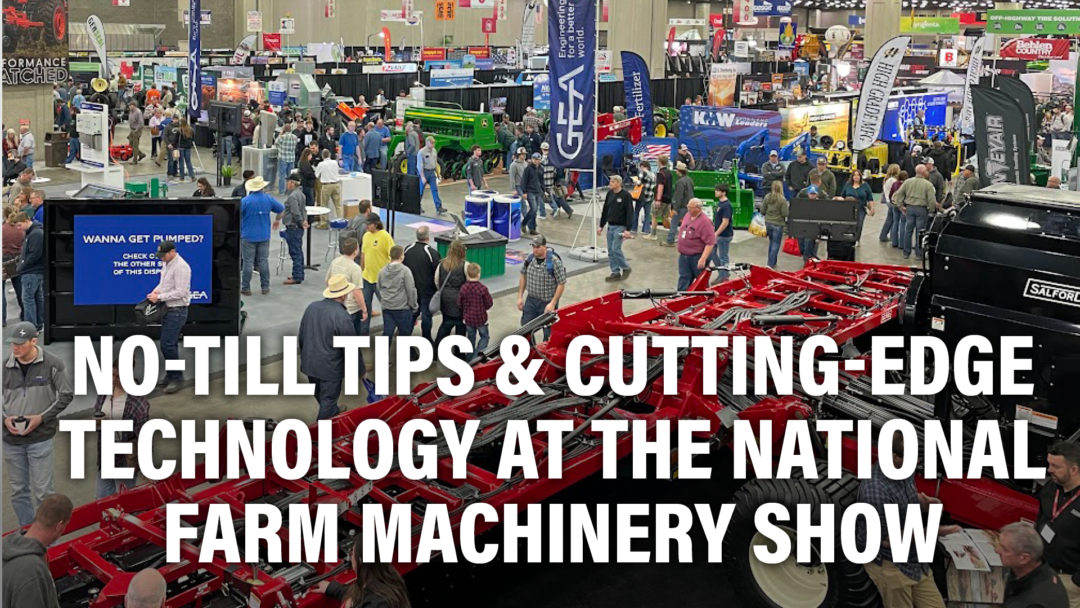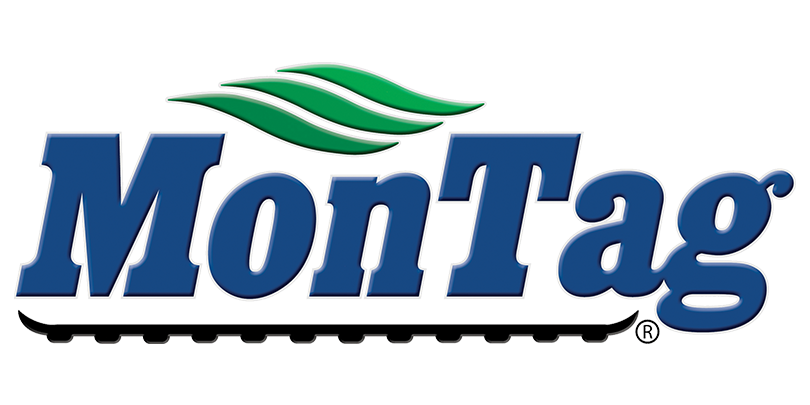On this episode of Conservation Ag Update, brought to you by Montag Manufacturing, we’re on the road at the National Farm Machinery Show in Louisville, Ky. Jeff Hadacheck from Wisconsin-Madison discusses the long term economic benefits of integrating winter wheat in your corn-soybean rotation. Plus, we visit with Brandon Somers at the Beck’s Practical Farm Research (PFR) insights meeting. Somers talks about his ideal no-till planter.
Soil health powerhouse Blake Vince sits down with managing editor Michaela Paukner in the Cover Crop Connection. Also in the episode, philanthropist and no-till advocate Howard Buffett discusses the role conservation ag plays in his worldwide humanitarian efforts, a pair of no-tillers share their thoughts on autonomy and Andy Waters of Linco-Precision explains how to do the Flag Test this spring after planting.
This episode of Conservation Ag Update is brought to you by Montag Mfg.
Montag Manufacturing has rolled out two new industry-first products. Cover Crop Plus is the first metering system dedicated to cover crop seeds, able to accurately meter even the smallest seeds like cover cress. It can be mounted to tillage implements, combines and self-propelled high clearance machines.
The second new product is the mammoth sized model 2224 with 13 or 16 tons capacity for producers running with larger strip-till implements. For more information, visit the Montag website or your Montag dealer.
TRANSCRIPT
Jump to a section or scroll for the full episode...
- The Economic Benefits of Adding Wheat to Corn-Soybean Rotation
- What’s on Your Ultimate No-Till Planter?
- Advice for Building a Multi-Species Cover Crop Mix
- Howard Buffett Discusses Worldwide Conservation Ag Efforts
- Will Automation & Autonomy Have a Place on Your Farm Soon
- How to Perform the Flag Test to Measure Emergence
The Economic Benefits of Adding Wheat to Corn-Soybean Rotation
Welcome to the National Farm Machinery Show in Louisville, Ky., the backdrop for this edition of Conservation Ag Update. We’ll be floating around the show over the course of the episode. But let’s kick things off in Wisconsin, where the Dodge County Farmers held their annual Soil Health Expo. Jeff Hadacheck, assistant professor and extension specialist for the department of agricultural and applied economics at Wisconsin-Madison, talked about the long-term yield and soil health benefits of implementing winter wheat into corn and soybean rotations.
“It really is sort of a staggered effect, where maybe you see down years and maybe lower returns in wheat years, but in those years following wheat into the rotation, you see benefits into the corn and soybeans. When we’re implementing conservation practices, whether it’s conservation cropping, cover crops or alternative strategies, you do have costs associated with them. I think it’s important to consider the time span, when you think about implementing these systems rather than just year-to-year returns, because sometimes those year-to-year returns shade the fact that you’re getting benefits in those off years.”
What’s on Your Ultimate No-Till Planter?
More from that meeting in just a bit, but now we're here with Brandon Somers in the Becks Practical Farm Research Insight Center here. You just did a round table discussion. How much do you enjoy getting out here and sharing some of the results from the 2023 research?
Yeah, this is one of the most fun things we do. Just come out and share everything that we worked hard on this summer. It's really gratifying for all of us to be able to share it with customers and see and can take it to the field.
And one of the questions you got here that I thought really stood out is everything from this research book. Given that if you had an unlimited budget, what's going on in your ultimate planter? And in this case, a lot of our audience are no tillers and strip tillers. So what would go on you ultimate planter with an unlimited budget?
Yeah, so that's a tough question because there's a lot of good options out there, but I think there's two things I think are tied for number one. First is downforce. Hydraulic downforce is really kind of changed the game, especially for no-till. Being able to change that downforce as the plant's going across the field multiple times within a second, that's making a big difference. Even in our small plots of being 300 to 400 feet long, we're seeing advantages in it. And that's pretty usually some fairly consistent ground. Number two is two by two by two. Being able to put some nitrogen down right next to where that plant needs it to get that plant off to the best start we can, I think is really key. Those two are probably my top one to go to.
Number two, I think having a good meter system is key. We want to have good singulation out there, good placement of that seed. And when I say metering system, that kind of goes into having something like a speed tube on there. Being able to control that drop all the way until that seed gets in the ground. Because from that point on, we do nothing but lose yield potential. So let's get it set up for the best steel potentially we had to get. And then number three, I think is closing wheels, especially in a no-till situation, that can make a big difference. We want to get that seed trench closed, protect that seed, get good seed flow of contact. It's good for germination. Keep some of the pests out of the trench. And all the testing we've done, we've tested a lot of different closing wheels. Anything we put on here seems to be better than just that standard rubber thats on our closing system that we particularly see.
There you go. The ultimate planter. If you have an unlimited budget from Brandon here, and we're going to be breaking down the research from this book here in the coming weeks on no-till farmer.com.
Advice for Building a Multi-Species Cover Crop MixThis week, check out some advice from Merlin, Ontario no-tiller Blake Vince, on how to go about putting together a multi-species cover crop mix.
“First I like to use a ballpoint pen and I like to reference the seed size spectrum, because seeds inevitably are smaller and larger. So, at the clicker end of the ballpoint pen — if you can imagine seed that’s large like a fava bean, and then at the opposite end where the ballpoint is of the pen, you would have a seed like canola or kale — something that is very small like Phacelia. And then in the median of that range would be a seed like soybeans. So, people inevitably will ask me how can you plant all this diverse blend without it sort of settling out of your seed or your seed plant or the box of your drill or whatever. And I set the drill based on the size of the average seed in the blend which is typically soybeans. So you just look at your chart for your specific planter and if you want to have 50 pounds of soybeans you just open up the opening based on what the book would say or the chart as it pertains to your drill or your air seeder and it's very, very easy to do that.”
Stay tuned for an upcoming No-Till Farmer article with more tips and info from Blake Vince regarding best practices for multi-species cover crop mixes. That’s all for this week’s cover crop connection. Until next time, back to you, Noah.
Howard Buffett Discusses Worldwide Conservation Ag Efforts
We’re standing in front of the John Deere booth now because this next story is about philanthropist and no-till advocate Howard Buffett, who spearheaded a program that delivered well over 100 new combines and planters to Ukraine, many of which were John Deere models. Buffett spoke about his worldwide humanitarian efforts at the National No-Tillage Conference last month in Indianapolis, and how conservation ag is such a big part of it.
“When you start talking cover crops in Africa, people think you’re a little crazy. Because how could they grow anything that they weren’t going to eat or use for cattle, but primarily eat? It’s an uphill battle in terms of trying to fit some of those things into a production system. And it’s not much of a system in some places, but we’re doing a project in Rwanda, we’re probably 11, 12 years into it. We have taken the farmer’s income and increased it by 15 times. And now in the last three years now, we’ve gotten some farmers to begin to use more or less, very hard to talk about cover crops still over there and even in this environment. But we’re making progress on it. And in Central America we’ve made a lot of progress with it. It’s really interesting. And sometimes it has to do with the environment, what’s available. What can you export? What are your sales opportunities? But everywhere we go we try to make sure we can apply as many principles of conservation ag as we can. And people will come up with regenerative ag and all these other names, and I just still call it conservation ag, because that’s what it is.”
Check out New Holland’s CR11 combine, making its North American debut here.
Will Automation & Autonomy Have a Place on Your Farm Soon?
This right here is the IntelliSpread radar. It automates the spreading control to ensure even residue coverage behind the combine. We see a lot of this cutting-edge technology here at the show. How close is automation and autonomy to having a place on your farm? I asked no-tillers Tim Norris and Joe Hamilton that question at the Precision Farming Dealer Summit.
“Last year, we had a Fendt on the farm. And we had a group from Brazil coming up. And AG Info Tech brought this Sabanto Fendt out and we got to mow 40 acres of pasture with it. And it was really neat to see. So, I'm really looking forward to it. I don't know if I'm going to be able to afford it, if you have to have a brand-new tractor and the technology on top of that. But if it will retrofit to tractors that are 10, 15 years old, I could see it having a fit.”
“Joe, is autonomy, does it seem like a science fiction movie to you, or is it pretty close to having a place on your farm?”
“No, I think it's close. If Tesla can create a self-driving car that can drive down the highway with all the unknowns and variables present on the highway, why can't we make a tractor that drives itself in the field? I would use it as a time savings. If I can spray 90 acres an hour sitting in the sprayer, I don't want to be able to spray 90 acres an hour standing by the side of the field babysitting the autonomous sprayer. It has to be a time savings for me. But with weather events every year, shortening my planting window. A lot of times I'm riding the planter one day and spraying the next. And if I have 10 good days to plant and I just burn up one of those because I had to get out of the planter and get in the sprayer, it's very inefficient for me in my operation. I think autonomy will take a place on his farm. But just like Tim said, it's going to be cost. I don't cover 25,000 acres, I cover 2,500. So, it has to be a cost-effective solution for me.”
How to Perform the Flag Test to Measure Emergence
Wrapping things up with the Video of the Week. And this one’s about the Flag Test, which is a simple way to find out if you have uneven emergence. Andy Waters from Linco-Precision in central Illinois explains how it works.
“So the flag test is essentially you've got different colored or different marked day flags. So you've got day 1, 2, 3, and four and you basically go out like let's say this is Monday at eight o'clock, go out at Monday at eight o'clock and I mark any plants that are emerged with the red flag. Then I'll come back on day two at eight o'clock and any plants that were not already marked that are up now, I'll mark with a day two and I'm measuring out on 30 inch rows, 17 foot five inches. And then day three I'll come back with another flag and mark any plants that are day three. So you can see the consistency of emergence like we talked about. You lose basically 8% if it emerges after 12 hours or I'm sorry, after 24 hours. After 36 hours you're losing 30 something percent and after 48 hours you're losing 68%. So you can see how much of an effect that would take. And ideally you have all one Keller, it's all day one. But very rarely do I see that. Very rarely do I ever see actually on a 36,000 population I see 36,000. Usually it's 34 or 33, something like that.”
That will wrap things up. Have an interesting photo or video from your farm? Or a story you’d like us to feature on the broadcast? Send me an email at Nnewman@lesspub.com.
And that will wrap things up this edition of Conservation Ag Update. Until next time, for more stories visit no-tillfarmer.com, striptillfarmer.com and covercropstrategies.com. Thanks for stopping by. Have a great day!








